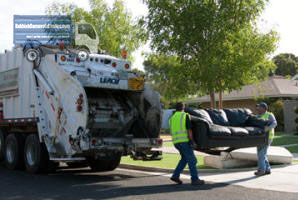Curbside collection is the term used to describe the commonly used rubbish removal system in many countries around the world. Also known as kerbside collection, this rubbish removal practice is generally available to households and businesses in metropolitan and suburban areas. Curbside rubbish removal is provided by local councils and paid for through local taxes owed by residents.
In a nutshell, municipal curbside collection of general household and commercial waste is done by specially trained and equipped personnel, using a purpose-built rubbish removal vehicle i.e. the garbage truck all people are familiar with.
Prior to the nineteen hundreds, human settlements in developed or industrialised cities did not generate that much household waste (note household, not industrial waste). Most of the time, rubbish was burnt in the fire, tossed out the window, buried in the garden or deposited in outhouses. One of the first organised rubbish collection operations to be put in place was in London where night men or gong farmers went around the city at night collecting household waste.
Although, some sort of rubbish removal system was implemented and working relatively fine, the problem with waste management still remained. At the time, people were already aware that tossing all sorts of waste in nearby rivers and lakes is not an option as it created pollution and health problems. London waste for example, since Roman times, has been dumped outside the London Wall near the Thames. On the other side of the puddle, in Manhattan, NY rubbish removal practices were as wild as they could be! At one stage, local councils actually roamed hogs through the streets so they can eat up as much garbage as possible. Oddly enough the practice caught on, though swine were no longer running the streets of large cities. Instead, there were special farms established where swine were fed with waste.
 London did indeed have the first organised rubbish removal system, but over the English Channel in Paris, France people saw the introduction and implementation of the first ever integrated rubbish removal and recycling system. In eighteen eighty four, Eugene Poubelle came up with the proposal that people should separate household waste into perishables items, paper, cloth, crockery and shells. Eugene Poubelle was also the founder of the standard urban rubbish bin. Paris was the first city in the world to install standard sized rubbish bins throughout metropolitan areas. While Poubelle was in charge of Paris’ rubbish collection and disposal system, organic waste was properly collected, transported and composted outside the city. This effective waste management practice was in place well into the nineteen hundreds, when the introduction and mass use of plastics created soil and water pollution.
London did indeed have the first organised rubbish removal system, but over the English Channel in Paris, France people saw the introduction and implementation of the first ever integrated rubbish removal and recycling system. In eighteen eighty four, Eugene Poubelle came up with the proposal that people should separate household waste into perishables items, paper, cloth, crockery and shells. Eugene Poubelle was also the founder of the standard urban rubbish bin. Paris was the first city in the world to install standard sized rubbish bins throughout metropolitan areas. While Poubelle was in charge of Paris’ rubbish collection and disposal system, organic waste was properly collected, transported and composted outside the city. This effective waste management practice was in place well into the nineteen hundreds, when the introduction and mass use of plastics created soil and water pollution.
After the start of the twentieth century, with the arrival of consumable goods and disposable products, local councils around the world banned waste dumping and moved on to properly organised rubbish collection systems i.e. curbside collection. During the same period, the standard rubbish bin used in many countries was Eugene Poubelle’s design. The nineteen sixties saw the introduction of the now classic, black nylon garbage bag.

